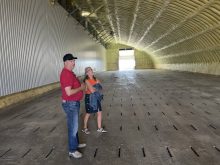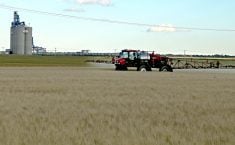System measures distance between whorls and the number, angles and diameters of nodal roots for 12 corn genotypes
The University of Georgia has developed a unique image-based, three-dimensional root phenotyping platform to help better understand plant root systems.
The system can measure 18 physical traits of field-grown corn root crowns to analyze and understand root growth and root responses in field environments.
Until recently, farmers and plant breeders did not have an efficient way to gather information about a plant’s root system.
Now, with the introduction of the DIRT/3D (Digital Imagine of Root Traits) platform, researchers can examine all traits and characteristics of roots including the distance between whorls and the number, angles, and diameters of nodal roots for 12 contrasting corn genotypes.
Read Also

New coal mine proposal met with old concerns
A smaller version of the previously rejected Grassy Mountain coal mine project in Crowsnest Pass is back on the table, and the Livingstone Landowners Group continues to voice concerns about the environmental risks.
Suxing Liu, a research associate at the university, developed the model at the computational plant science laboratory operated by Alexander Bucksch, an associate professor of plant biology.
“A maize root system consists of different types of roots such as nodals that emerge at different locations (whorls),” said Bucksch. “We measure root diameters, rooting angles between the soil line and the root, and the number and distance of whorls.”
He said they also use the method to measure a new trait that describes the accumulation of root volume as a function of rooting depth.
“Since this is summarizing the shape of the root, we hope to get insight into the competition for nutrients between neighbours in the field,” he said. “If we find ways to lower the competition, we could get more yield even under stresses, such as drought or nutrient deficiencies, which are both consequences of climate change.”
The root crowns were excavated from the field using a method called Shovelomics.
“Shovelomics is a technique to excavate root systems,” he said. “It is a very consistent way to get most of the root system out of the ground. Originally, a researcher had to measure all traits manually, which added a lot of subjectivity to the problem. DIRT 2D was the first repeatable way to measure traits in the field across large genetic diversity panels. With DIRT/3D we are able to resolve much of the inner root system architecture, which could not be done in 2D.”
DIRT/2D is the software forerunner to DIRT/3D and was launched in 2016. It has proven to be a valuable field tool used by scientists worldwide.
As a practical example, Bucksch cited a recent study exploring sorghum resistance to the parasitic plant witchweed (Striga hermonthica). Striga routinely destroys sorghum harvests in much of Africa. Bucksch wrote in the media release that a researcher at the University of California, Davis, using DIRT/2D technology, found that there are some varieties of sorghum with Striga-resistant roots. She mapped those resistant traits to genes that regulate the release of chemicals.
The DIRT/3D study involved a camera set-up and micro-computers. Ten cameras were each connected to 10 Raspberry Pi computers (tiny, single-board, open-design, low-cost devices). Each computer triggered its camera to take a photo while the arc they were mounted on rotated around the root complex. The system took about 2,000 images from a variety of angles. The images were transferred from the cameras to the micro-computers and the data was then transferred to the CyVerse Data Store (the U.S. cyberinfrastructure resource for researchers). The system then generated a 3D high resolution image, or “point cloud” that represented every root node and whorl, a digital twin of the root system that could be studied, stored and compared. The process to create the 3D imaging was made possible by the huge number-crunching capabilities provided by the Texas Advanced Computing Center (TACC).
“The data collection (from the root crown) takes only a few minutes, which is comparable to an MRI or X-ray,” said Bucksch. “The rig only costs a few thousand dollars to build, making the technology scalable to perform high-throughput measurements of thousands of specimens, which is needed to develop new crop plants for farmers.”
However, the data processing to create the final image and quantify the features takes several hours and requires many processors computing in parallel.
“The potential of the technology is that it costs a fraction compared to other 3D technologies,” he said. “One can argue that we get a few traits less than other technologies in maize, however, maize is probably the most complex root to reconstruct. The majority of crop root systems are not as dense, and we can compute most of the relevant traits at a fraction of the cost.”
He said that, from a science community perspective, the next research stage is to develop a web platform that is available to everyone.
A preview is available at portnoy.cyverse.org. The goal is to grow this for the long term with, hopefully, financial support from major crop breeding companies.
The challenges facing farmers are expected to rise in coming years, with more droughts, higher temperatures, low-soil fertility, and the need to grow food in less greenhouse-gas producing ways. Roots that are adapted to these future conditions will help ease pressure on the food supply.
“The potential, with DIRT/3D, is helping us live on a hotter planet and managing to have enough food,” said Bucksch. “There could be a point where this planet can’t produce enough food for everybody anymore, and I hope we, as a science community, can avoid that by developing better drought adapted and CO2 sequestering plants.”
The research was recently published in the journal Plant Physiology.

















